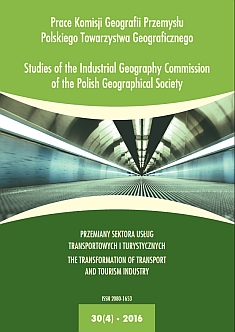Modeling of Accessibility and Mobility in the Context of Regional Differences in Total Population, GDP and Commercial Law Companies
DOI:
https://doi.org/10.24917/20801653.304.2Keywords:
business trips, gravity model, potential accessibilityAbstract
The article is an original synthesis of accessibility and mobility modelling that is carried-out in the Institute of Geography and Spatial Organization, Polish Academy of Sciences (IGSO PAS). The paper takes into account the spatial context of industry development in Poland, with particular emphasis on the spatial dis- tribution of population, GDP and location of commercial companies. The potential accessibility in HGV trans- port, where attractiveness depends on both population and GDP is taken into consideration. For the empirical analysis the OGAM application was used. In the part of the paper devoted to mobility issues, a model uses the results of the distribution of traffic on the national and voivodeship road network and VISUM software. The original method compares the results of the gravity model for travel between commercial companies carried out by entrepreneurs (businessmen, sales representatives, etc.) with the real traffic distribution. The overestimation/underestimation of traffic with respect to the results of the General Traffic Survey in 2010 was shown. Both in the accessibility and mobility studies a matrix of travel time at the municipal level (2,321 units) was used. Speeds were calculated based on the IGSO PAS speed model. It was pointed out that the potential and gravity models are still not very popular methods of analysis of determinants of industrial de- velopment in Poland. They provide the opportunities for indicating potential locations for new investments in the context of both freight transport and business travelDownloads
References
Bruinsma, F.R., Rietveld, P. (1998). The Accessibility of European Cities: Theoretical Framework and Comparison of Approaches. Environment and Planning, 30(3), 499–521.
Generalny pomiar ruchu (2010). Generalna Dyrekcja Dróg Krajowych i Autostrad. Pozyskano z www.gddkia.gov.pl
Geurs, K.T., van Wee, B. (2004). Accessibility Evaluation of Land-use and Transport Strategies: Review and Research Directions. Journal of Transport Geography, 12, 127–140.
Guzik, R. (2003). Przestrzenna dostępność szkolnictwa ponadpodstawowego. Kraków: Instytut Geografii i Gospodarki Przestrzennej Uniwersytetu Jagiellońskiego.
Guzik, R., Kołoś, A. (red.) (2015). Relacje funkcjonalno-przestrzenne między ośrodkami miejskimi i ich otoczeniem w województwie pomorskim. Gdańsk: Urząd Marszałkowski Województwa Pomorskiego.
Handy, S.L., Niemeier, D.A. (1997). Measuring Accessibility: an Exploration of Issues and Alternatives. Environment and Planning A, 29, 1175–1194.
Hansen, W.G. (1959). How Accessibility Shapes Land-use. Journal of the American Institute of Planners, 25, 73–76.
Komornicki, T., Śleszyński, P., Rosik, P., Pomianowski, W. (2010). Dostępność przestrzenna jako przesłanka kształtowania polskiej polityki transportowej. Biuletyn Komitetu Przestrzennego Zagospodarowania Kraju Polskiej Akademii Nauk, 241.
Korcelli, P., Degórski, M., Drzazga, D., Komornicki, T., Markowski, T., Szlachta, J., Węcławowicz, G., Zaleski, J., Zaucha, J. (2010). Ekspercki projekt koncepcji przestrzennego zagospodarowania kraju do roku 2033. Studia Komitetu Przestrzennego Zagospodarowania Kraju, 128.
Kulpa, T. (2013). Modelowanie potencjałów ruchotwórczych w drogowych przewozach ładunków w skali regionu. Praca doktorska. Biblioteka Cyfrowa Politechniki Krakowskiej.
Rosik, P. (2012). Dostępność lądowa przestrzeni Polski w wymiarze europejskim. Prace Geograficzne. Instytut Gospodarki i Przestrzennego Zagospodarowania PAN, 233.
Rosik P., Kowalczyk, K. (2015). Rozwój infrastruktury drogowej i kolejowej a przesunięcie mo- dalne w Polsce w latach 2000–2010. Prace Geograficzne. Instytut Geografii i Przestrzennego Zagospodarowania PAN, 248, 216.
Rosik, P., Stępniak, M. (2015). Monitoring of changes in road potential accessibility at municipal- ity level in Poland, 1995–2015. Geographia Polonica, 88(4), 607–620.
Rosik, P., Stępniak, M., Komornicki, T. (2015). The decade of the big push to roads in Poland: Impact on improvement in accessibility and territorial cohesion from a policy perspective. Transport Policy, 37, 134–146.
Rosik, P., Śleszyński, P. (2009). Wpływ zaludnienia w otoczeniu drogi, ukształtowania po- wierzchni terenu oraz natężenia ruchu na średnią prędkość jazdy samochodem osobowym. Transport Miejski i Regionalny, 10, 26–31.
Szarata, A. (2010a). Kalibracja i możliwości weryfikacji wyników kompleksowych badań ruchu narzędziami symulacyjnymi, Kompleksowe badania ruchu – teoria i praktyka – doświadczenia miast polskich. Zeszyty Naukowo-Techniczne Stowarzyszenia Inżynierów i Techników Komunikacji w Krakowie, 93(12), 193–204.
Szarata, A. (2010b). Kalibracja więźby ruchu w oparciu o pomiary przekrojowe, VII Konferencja Naukowo-Techniczna „Systemy transportowe – teoria i praktyka”.
Wegener, M., Eskelinnen, H., Fürst, F., Schürmann, C., Spiekermann, K. (2001). Criteria for the Spatial Differentiation of the EU Territory: Geographical Position. Forschungen, 102.2. Bonn: Bundesamt für Bauwesen und Raumordnung.
Downloads
Published
How to Cite
Issue
Section
License
Articles are published under the terms of the Creative Commons License (CC BY-ND 4.0; Attribution– NoDerivs).

